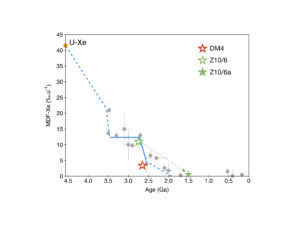Possible discontinuous evolution of atmospheric xenon suggested by Archean barites.
M. G. Almayrac, M. W. Broadley, D. V. Bekaert, A. Hofmann, B. Marty
2021. Chemical Geology, 581, 120405.
doi: 10.1016/j.chemgeo.2021.120405
 The Earth’s atmosphere has continually evolved since its formation through interactions with the mantle as well as through loss of volatile species to space. Atmospheric xenon isotopes show a unique and progressive evolution during the Archean that stopped around the Archean-Proterozoic transition. The Xe isotope composition of the early atmosphere has been previously documented through the analysis of fluid inclusions trapped within quartz and barite. Whether this evolution was continuous or not is unclear, requiring additional analyses of ancient samples, which may potentially retain remnants of the ancient atmosphere. Here we present new argon, krypton and xenon isotopic data from a suite of Archean and Proterozoic barites ranging in age from 3.5 to 1.8 Ga, with the goal of providing further insights in to the evolution of atmospheric Xe, whilst also outlining the potential complications that can arise when using barites as a record of past atmospheres. Xenon released by low temperature pyrolysis and crushing of two samples which presumably formed around 2.8 and 2.6 Ga show Xe isotope mass dependent fractionation (MDF) of 11‰.u−1 and 3.4‰.u−1, respectively, relative to modern atmosphere. If trapped Xe is contemporaneous with the respective formation age, the significant difference in the degree of fractionation between the two samples provides supporting evidence for a plateau in the MDF-Xe evolution between 3.3 Ga and 2.8 Ga, followed by a rapid evolution at 2.8–2.6 Ga. This sharp decrease in MDF-Xe degree suggests the potential for a discontinuous temporal evolution of atmospheric Xe isotopes, which could have far reaching implications regarding current physical models of the early evolution of the Earth’s atmosphere.
The Earth’s atmosphere has continually evolved since its formation through interactions with the mantle as well as through loss of volatile species to space. Atmospheric xenon isotopes show a unique and progressive evolution during the Archean that stopped around the Archean-Proterozoic transition. The Xe isotope composition of the early atmosphere has been previously documented through the analysis of fluid inclusions trapped within quartz and barite. Whether this evolution was continuous or not is unclear, requiring additional analyses of ancient samples, which may potentially retain remnants of the ancient atmosphere. Here we present new argon, krypton and xenon isotopic data from a suite of Archean and Proterozoic barites ranging in age from 3.5 to 1.8 Ga, with the goal of providing further insights in to the evolution of atmospheric Xe, whilst also outlining the potential complications that can arise when using barites as a record of past atmospheres. Xenon released by low temperature pyrolysis and crushing of two samples which presumably formed around 2.8 and 2.6 Ga show Xe isotope mass dependent fractionation (MDF) of 11‰.u−1 and 3.4‰.u−1, respectively, relative to modern atmosphere. If trapped Xe is contemporaneous with the respective formation age, the significant difference in the degree of fractionation between the two samples provides supporting evidence for a plateau in the MDF-Xe evolution between 3.3 Ga and 2.8 Ga, followed by a rapid evolution at 2.8–2.6 Ga. This sharp decrease in MDF-Xe degree suggests the potential for a discontinuous temporal evolution of atmospheric Xe isotopes, which could have far reaching implications regarding current physical models of the early evolution of the Earth’s atmosphere.
